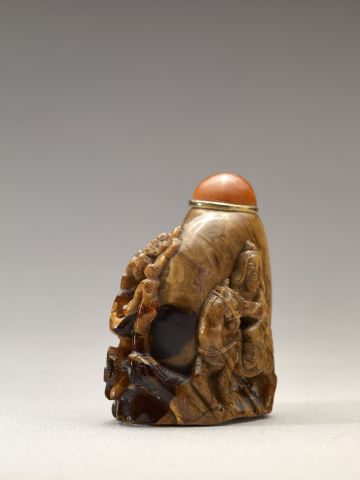

Bottle ID: 50
ROOT, PEBBLE CARVED WITH MENG HAOREN ON MULE
Date: 1780-1850
Height: 51 mm
Amber, well hollowed, of opaque honey brown and mottled transparent dark brown tones, of irregular pebble form, carved with a continuous scene of Meng Haoren riding his mule in a rocky landscape beside a blossoming prunus tree.
Similar Examples:
Moss, Hugh, Victor Graham and Ka Bo Tsang. The Art of the Chinese Snuff Bottle - The J & J Collection, 1993, Vol.II, pp. 502-504, no. 297.
Holden, Rachelle R. Rivers and Mountains Far From the World - The Rachelle R. Holden Collection, 1994, pp. 92-93, no. 33.
Sotheby's, New York, July 1, 1985, lot 97, The Kardos Collection.
Stevens, Bob C. The Collector's Book of Snuff Bottles, 1976, pp. 283, no. 1023
Provenance:
Clare Lawrence Ltd.
Sotheby's, New York, November 22, 1988, lot 41
Sotheby's, New York, March 26, 1982, lot 192
Bob C. Stevens
Exhibited:
Detroit Institute of Art, April-October, 1986
An Exhibition of Chinese Snuff Bottles and Dishes from The Bob C. Stevens Collection, Mikimoto Hall, Tokyo, 22-31 October, 1978
Published:
Chinese Snuff Bottles and Dishes. Catalogue of an Exhibition from the Collection of Bob C. Stevens, Mikimoto Hall, Tokyo, 1978, p.96, no. 274
Stevens, Bob C. The Collector's Book of Snuff Bottles, 1976, pp. 178-179, no. 702
Moss, Hugh M. (ed.) Chinese Snuff Bottles: 4, 1966, p. 52, no. 20
Bob Stevens, in his book, publishes this wonderfully carved bottle but only chooses to illustrate the side which the prunus blossom is carved on and in the image caption does not mention the figure on the mule. He does point his out in his commentary on page 190, where he mentions that Hugh Moss in his magazine, no. 4, publishes the other side. Luckily, the same stopper has remained with this bottle so that we can be sure that it is in fact, the Stevens bottle. Interestingly, Stevens states that the contrasting 'effects' of the bottle are rendered by the 'clever carving techniques' rather than by differences in the material which is so often the case with this group of bottles. A more detailed carved bottle that is clearly also from this group is shown in the back of the Stevens book in the chapter on his "Favorites Among the Favored".
< Back to full list

 English
English 中文
中文